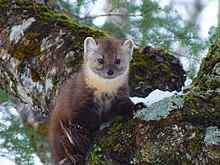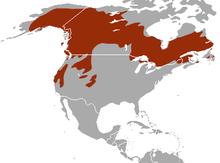Our website is made possible by displaying online advertisements to our visitors.
Please consider supporting us by disabling your ad blocker.
American marten
| American marten | |
|---|---|

| |
| Newfoundland pine marten, a subspecies of the American marten | |
| Scientific classification | |
| Domain: | Eukaryota |
| Kingdom: | Animalia |
| Phylum: | Chordata |
| Class: | Mammalia |
| Order: | Carnivora |
| Family: | Mustelidae |
| Genus: | Martes |
| Species: | M. americana
|
| Binomial name | |
| Martes americana | |
| Subspecies[4] | |
| |

| |
| American marten range (note: map is missing distribution in parts of Wisconsin, Michigan, New York, and New England; includes a range of Pacific marten) | |
| Synonyms | |
| |
The American marten[1] (Martes americana), also known as the American pine marten, is a species of North American mammal, a member of the family Mustelidae. The species is sometimes referred to as simply the pine marten. The name "pine marten" is derived from the common name of the distinct Eurasian species, Martes martes. Martes americana is found throughout Canada, Alaska, and parts of the northern United States. It is a long, slender-bodied weasel, with fur ranging from yellowish to brown to near black. It may be confused with the fisher (Pekania pennanti), but the marten is lighter in color and smaller. Identification of the marten is further eased by a characteristic bib that is a distinctly different color than the body. Sexual dimorphism is pronounced, with males being much larger.
The diet is omnivorous and varies by season, but relies chiefly on small mammals like voles. They are solitary except during the mid-summer breeding season. Embryonic implantation is delayed until late winter, however, with a litter of 1–5 kits born the following spring. Young stay with the mother in a constructed den until the fall and reach sexual maturity by one year old.
Their sable-like fur made them a thoroughly trapped species during the height of the North American fur trade. Trapping peaked in 1820, and populations were depleted until after the turn of the century. Populations have rebounded since, with them being considered a species of least-concern by the IUCN; however, they remain extirpated from some areas of the Northeast, and of the seven subspecies, one is threatened.
- ^ a b Helgen, K.; Reid, F. (2016). "Martes americana". IUCN Red List of Threatened Species. 2016: e.T41648A45212861. doi:10.2305/IUCN.UK.2016-1.RLTS.T41648A45212861.en. Retrieved 19 February 2022.
- ^ "NatureServe Explorer 2.0". explorer.natureserve.org. Retrieved 30 March 2022.
- ^ Wilson, D. E.; Reeder, D. M., eds. (2005). "Martes americana". Mammal Species of the World: A Taxonomic and Geographic Reference (3rd ed.). Johns Hopkins University Press. ISBN 978-0-8018-8221-0. OCLC 62265494.
- ^ Martes americana, MSW3
- ^ Youngman, Phillip M.; Schueler, Frederick W. (1991). "Martes nobilis Is a Synonym of Martes americana, Not an Extinct Pleistocene-Holocene Species". Journal of Mammalogy. 72 (3): 567–577. doi:10.2307/1382140. JSTOR 1382140.
Previous Page Next Page




